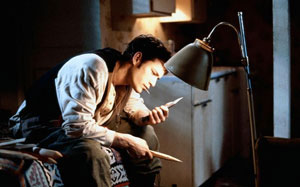With the tragic death of Luke Perry (1966-2019) from a stroke this past week, there’s been an influx of “Buffy” fans announcing that they loved him as Pike in the 1992 “Buffy” movie and they are rewatching the film in his honor. Some are even going so far to say they like the movie, giving it a bizarre short-term boost in cult popularity.
Best part of the movie?
Not to denigrate some people’s enjoyment of the film, but I think it’s objectively bad and an insult to Joss Whedon, who wrote a strong origin story that got rewritten and turned into high camp by director Fran Rubel Kuzui, actor Donald Sutherland and other people in power on the set. Whedon’s first produced film script stands as a case study in a movie being yanked away from the screenwriter and turned into something he didn’t intend.
But there’s one reason why the “Buffy” movie can’t be totally dismissed: Perry as Oliver Pike, who in shorthand is Xander (awkward outcast), Oz (casual coolness and a rarely mentioned full name) and Angel (potential boyfriend material) rolled into one.
He admires popular senior cheerleader Buffy from afar but can’t enter her social circle. But then Buffy gets knocked into his social circle (outcast) when she’s called as a Slayer, and suddenly he is not just her friend, but her only friend.
When Whedon rejiggered Buffy’s origin story for the TV series (1997-2003), he pushed Buffy back to sophomore year of high school and cast the younger Sarah Michelle Gellar in place of Kristy Swanson.
Also carrying over from the movie are Merrick (in the “Becoming, Part One” flashbacks, he’s reinvented to look as physically different as possible, the rotund Richard Riehle stepping in for the lanky Sutherland), and Joyce and Hank Summers (who aren’t named in the film). Hank continues as an absent father, but Joyce has become a loving, concerned mother.
On TV, no place for Pike
Whedon was partly washing his hands of the movie, but Buffy’s transition from a carefree and even bubble-brained popular girl to a Slayer carrying the weight of the world was still obviously important – thus we get the “Becoming” flashbacks and, more robustly, Dan Brereton’s and Christopher Golden’s “The Origin” comic book (1999). The writers essentially imagine Whedon’s script if it were directed by Whedon in 1996 rather than directed by Kuzui in 1992.
Drawing a stark line in the sand between the Hemery High and Sunnydale High chapters of Buffy’s life, none of her popular friends from Los Angeles are ever mentioned in the TV series. Nor are they mentioned in the spinoff novels or comics, aside from an author’s occasional broad pontification about how Buffy has changed. Even in Michelle West’s excellent short story “Dust” from “How I Survived My Summer Vacation,” the friend who Buffy visits in LA – Amber – is not one of the movie/“Origin” characters.
Pike is left out of the TV show because there isn’t a spot for him; Xander, Oz and Angel fill his character traits (and there’s maybe a dash of Pike in “Angel’s” Doyle, too). While Merrick, Joyce and Hank are (hugely or slightly) reinvented and recast, Perry’s performance as Pike is a rare part of the film that matches Whedon’s vision.

Were he to appear in the TV series, though, he would have to be recast for age purposes, thus giving the new actor big shoes to fill. All told, it was better to leave Pike in the past, not out of disrespect for Perry’s work but out of respect.
Saved by spinoff fiction
But spinoff fiction gives writers the opportunity to dig into deeper corners of the saga, so we shouldn’t be surprised that Pike pops up in three more stories after “The Origin.” In timeline chronological order, he appears in the comic arc “Viva Las Buffy!” (“BTVS Classic” Issues 51-54, 2002-03), set immediately after “The Origin”; the novel “Sins of the Father” (1999), set during Season 3; and the comic arc “Note from the Underground” (“BTVS Classic” Issues 47-50, 2002), set after Season 6.
The comic authors draw what I’d call a generic Pike; he looks like any ol’ turn-of-the-century nonconformist young man — often retaining the soul patch — rather than specifically like Perry. And the “Sins” cover stylizes Pike’s mug from the movie so it’s sort of Perry’s likeness and sort of not. Again, I don’t think this is out of disrespect for Perry’s work; it’s just a concession to the fact that the Pike for the rejiggered timeline couldn’t be played the same actor.
“Viva Las Buffy!” picks up from the end of the movie/“Origin,” wherein Buffy and Pike go to Las Vegas, a setup for a sequel. Whedon never wrote a sequel screenplay, although I wonder if he at least had a Vegas adventure vaguely in mind. Interestingly, “Sins of the Father” author Golden and “Viva Las Buffy!” writers Scott Lobdell and Fabian Nicieza have contradictory ideas of what happens in Vegas.
Most notably, in backstory within “Sins,” Buffy says Pike fell under a demon’s thrall and she had to hurt him, thus resulting in a scar above his eye. While this sounds fascinating, in “Viva Las Buffy!,” Lobdell and Nicieza excise the possession idea for a more streamlined story that illustrates Buffy’s natural Slayer talents through the admiring eyes of Pike (including one of my favorite examples of how Buffy dispatches a roomful of vampires – by adding holy water to the sprinkler system).
The romantic tension is real
Still, Lobdell and Nicieza do flesh out Pike’s character and clarify that there is romantic tension between him and Buffy (albeit more so on his side of the ledger). He is torn between wanting to help Buffy and wanting to leave. He can see that she always has one eye on him, worrying about his safety. Plus, he’s always had low self-respect, even outside of the question of his worth to Buffy.
He tries to commit suicide by jumping off a roof, as a way to remove himself from the equation so Buffy can focus on slaying. “Viva Las Buffy!” is ultimately a moving tale of Pike’s unrequited love for Buffy, and we can understand why he would leave despite caring deeply for her.
“Sins of the Father” continues to explore Pike’s troubled nature. Riding into Sunnydale seeking Buffy’s help against a demon who is hunting him, Pike claims he left at the end of “Viva Las Buffy!” because he didn’t want to commit to fighting evil. That may very well be true, but loyalty remains a key trait of Pike’s. The reason the rock demon, Greyhewn, is on his tail is that Pike killed its mate in defense of his own friend.
While “Viva Las Buffy!” emphasizes that he leaves Buffy’s side for the sake of Buffy’s focus on slaying, it could also be true that he genuinely doesn’t want to wade into the bigger fight against evil and feels he would bring nothing to the table anyway.
Indeed, Golden illustrates that Pike is not a larger-than-life hero, and this makes him a contrast to Xander and Willow and the other Scoobies, who choose to fight at Buffy’s side. Pike isn’t exactly admirable, but his contradictions make him fascinating and human.
A grace note
“Note from the Underground” then provides a grace note for Pike. He doesn’t join up with the Scoobies – by the nature of spinoff fiction tucked inside the TV narrative, he can’t – but he assists the gang in a battle against reconstituted Initiative monster Adam. In his defense, he sees that Buffy very much has a strong support group now.
And so Pike settles into his final, fated position in Buffyverse lore: Buffy’s only friend at the time when she most needed a friend. Along with practical considerations such as casting and narrative purpose, Whedon likely left Pike out of the TV series and canonical comics so Pike could retain that nostalgic status. Interestingly, the spinoff fiction writers allow Pike to always be the boy from Buffy’s past while also exploring his character further and clarifying his relationship with Buffy.
Golden, Lobdell and Nicieza take Pike beyond Perry’s portrayal, but not too far beyond. As readers, we still imagine Luke Perry’s Pike in our mind’s eye.
Full reviews:


“Viva Las Buffy!” and “Note from the Underground”

Main photo credit: 20th Century Fox/ Kuzui Enterprises/ Sandollar

